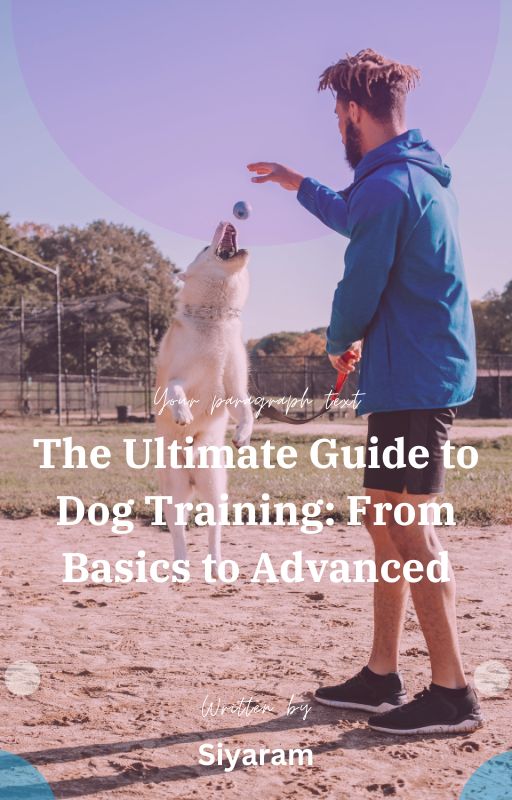The Ultimate Guide to Dog Training: From Basics to Advanced

Table of Contents
Introduction to Dog Training
Importance of Training and Why It Matters
Understanding Dog Behavior and Psychology
Setting Realistic Goals for Long-Term Success
Getting Started with Dog Training
Choosing the Right Training Method Based on Your Dog’s Needs
Essential Tools and Equipment for Effective Training
Creating a Positive and Engaging Training Environment
Basic Training Commands
Sit: Teaching Your Dog the First Essential Command
Stay: Reinforcing Patience and Control in Your Dog
Come: Strengthening Recall and Obedience Skills
Heel: Encouraging Proper Walking Behavior and Discipline
Leave It: Preventing Unwanted Behaviors and Ensuring Safety
Leash Training and Walking Etiquette
Choosing the Right Leash and Collar for Different Dog Sizes
Teaching Your Dog to Walk Without Pulling or Lunging
Handling Reactive Dogs and Managing Unwanted Walking Behaviors
House Training and Crate Training
Setting a Consistent Routine for Effective Housebreaking
Using Positive Reinforcement to Encourage Good Bathroom Habits
Managing Accidents and Preventing Future Housebreaking Issues
Socialization and Handling Aggression
Importance of Early Socialization for a Well-Adjusted Dog
Introducing Dogs to New People, Pets, and Environments Safely
Recognizing and Managing Aggressive Behaviors in Different Situations
Intermediate Training Techniques
Teaching Fun Tricks: Shake, Roll Over, Play Dead, and More
Impulse Control Exercises to Build Discipline and Patience
Teaching Your Dog to Wait Before Eating or Entering Rooms
Advanced Training Methods
Off-Leash Training for Greater Freedom and Control
Scent Work and Search Games to Enhance Mental Stimulation
Agility and Sports Training for Athletic and Active Dogs
How to Handle a Dog Carefully While Training
Understanding Dog Body Language to Improve Communication
Avoiding Negative Reinforcement and Harsh Training Techniques
Handling Nervous, Fearful, or Anxious Dogs with Care and Patience
Pro Tips for Successful Training
Consistency is Key: Establishing a Routine for Best Results
Patience and Positive Reinforcement as a Training Foundation
The Role of Proper Diet and Exercise in Behavioral Training
Pros and Cons of Different Training Approaches
Positive Reinforcement vs. Correction-Based Training: A Comparison
Group Training vs. Private Training: Which is Better for Your Dog?
DIY Training vs. Professional Help: Making the Right Choice
Conclusion
Final Thoughts on Dog Training and Its Long-Term Benefits
Encouraging Lifelong Learning and Development for Your Dog
Additional Resources and Further Reading for Continued Education
Introduction to Dog Training
Dog training is an essential part of responsible pet ownership, ensuring a well-behaved and happy dog that can thrive in different environments. Proper training strengthens the bond between the owner and their pet while promoting safety, discipline, and overall well-being. This eBook will guide you through fundamental training principles, starting from basic commands to advanced techniques, helping you raise a well-mannered and obedient dog.
Getting Started with Dog Training
Before beginning any training regimen, it is important to choose the right method that aligns with your dog’s temperament and learning style. Gathering essential tools such as treats, a leash, and a clicker will set you up for success. Creating a comfortable training space free from distractions will help your dog focus and learn more effectively. Positive reinforcement is the most widely recommended and humane training method, encouraging desired behaviors through rewards and praise.
Basic Training Commands
The foundation of a well-trained dog starts with mastering essential commands. Teaching Sit, Stay, Come, Heel, and Leave It will help establish good behavior and responsiveness. Each command should be introduced with patience, repetition, and rewards to ensure long-term retention and effectiveness.
Leash Training and Walking Etiquette
Proper leash training is necessary to prevent pulling and ensure enjoyable walks for both the dog and owner. Choosing the right equipment, using consistent commands, and rewarding good walking behavior will help your dog become a well-mannered and obedient walking companion.
House Training and Crate Training
Establishing a consistent routine is crucial for successful house training. Positive reinforcement helps encourage good bathroom habits while managing accidents effectively. Crate training can provide your dog with a safe and comfortable space while reinforcing discipline and preventing destructive behaviors.
Socialization and Handling Aggression
Introducing your dog to different environments, people, and other pets at an early stage is vital in reducing anxiety and aggressive tendencies. Recognizing warning signs and addressing behavioral issues before they escalate can prevent future problems and help your dog develop into a well-rounded companion.
Intermediate and Advanced Training Techniques
Once your dog has mastered the basics, you can progress to teaching fun tricks, working on impulse control, and even engaging in advanced training like agility or scent work. These techniques provide mental stimulation, strengthen obedience, and reinforce the bond between you and your dog.
How to Handle a Dog Carefully While Training
Understanding dog body language is a key component of effective training. It is essential to avoid punishment-based techniques that could damage trust and create fear. Instead, focusing on positive reinforcement and patience will build confidence and encourage a more cooperative learning experience.
Pro Tips for Successful Training
Training requires dedication, consistency, and proper motivation. Incorporating exercise and a balanced diet into your dog’s routine plays a significant role in shaping behavior. A well-structured approach to training leads to better results and a more harmonious relationship with your dog.
Pros and Cons of Different Training Approaches
Different training methods offer various benefits and drawbacks. Positive reinforcement is widely preferred for its effectiveness and humane approach, while correction-based methods may cause fear and anxiety. Understanding the advantages and disadvantages of each method will help you choose the best approach for your dog’s individual needs.